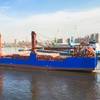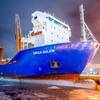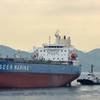The Arctic: Economic Promise or Environmental Peril?
The fervor to move shipping routes and energy business north of the Arctic Circle is palpable, as countries with physical connection and even ‘non-Arctic’ states are making moves and plans to stake claims to the vast potential that lies within.
While the maritime and subsea technology allowing ops in the Arctic’s harsh environs has moved forward fast, there are repeated and regular ‘warning shots across the bow’ of budding entrepreneurs large and small, as the Arctic environment is still largely undeveloped territory, representing risky operations for even the heartiest of souls. Last month in New London, Connecticut, at the United States Coast Guard Academy (USCGA), the USCGA and the Law of the Sea Institute from the University of California’s Berkeley School of Law convened a conference dubbed “Leadership for the Arctic,” a meeting which brought together government, academia and commerce to discuss the promise and peril north of the Arctic Circle. While discussions encompassed an array of technical, logistical and political matters, the overriding theme of the conference was ‘leadership’, or more specifically the vacuum of global leadership in matters governing the Arctic. “What we have is an ocean being used more than any time in history without any regulation,” summarized Lawson W. Brigham, PhD, Distinguished Professor, Geography and Arctic Policy, University of Alaska – Fairbanks. “There is a lot of work to be done in the future.”
Ice Cover: Shrinking but Viable
The Arctic ice cover is shrinking in tandem with the overall thickness of the ice. While a less ice-packed polar cap does offer opportunities, Dr. Brigham said: “I think it important to remind everyone that the place is ice-covered – fully or partially – eight to 10 months out of the year through the century and beyond. The ice cover is thinner, but it may be more dynamic, as it might be moving faster, meaning that it might not be an easier place to navigate.”
“I believe that all ships in the future in the Arctic will be Polar Class Ships for most of the year, highly regulated,” said Dr. Brigham. “So if you subscribe to this notion that there is going to be an ice-free shipping enterprise, climbing to the Arctic to create some sort of Panama or Suez Canal – think again.”
While a shorter route from Europe to Asia is enticing on a number of fronts, least of not which is the ability for shipping companies to drastically reduce shipment time, coupled with drastic reductions in fuel use and emissions, the prime driver for development in north of the Arctic Circle remains the discovery, recovery and shipment of oil and gas.
While computer models repeatedly show the summer retreat as much bigger, the ice has shown the tendancy to bounce back in the winter, and in fact just this past winter was a record maximum ice coverage in the Bering Sea. According to Dr. John Walsh, Chief Scientis, Alaska Center for Climate Assessment, computer models show that winter ice will be a major factor in the Arctic through 2090.
The Perils
Any discussion regarding maritime and offshore operations in the Arctic must start and end with the harsh climate. But the cold and ice are only part of the story. As the ice recedes further, the obvious result is more area of open water, and the Bering Sea Straight, for example, has become a ‘ground zero’ for low pressure systems, resulting in more frequent and much larger storm activities, according to Dr. Walsh. “The increased storm activity is real, not projected,” he said, and it will have serious impact on shipping and offshore activities, not to mention local shoreside communities.
Another challenge is the dearth of infrastructure and facilities to service a normal working maritime and offshore activities, in times normal and emergency. “Since there’s not much maritime infrastructure in the Arctic, it’s a huge issue. Only 6% of the Arctic Ocean is charted to international standards, and 11% is mapped.” In fact, there are only two areas in the reion – off the coast of Norway and the Northwest coast of Russia – that are considered to have world class maritime infrastructure.
The Promise
In assessing the risk versus reward for oil companies, Dr. Donald Gautier, Research Geologist, U.S. Geological Survey, puts it quite simply. “What matters is what can be technically recovered.”
When looking at the potential for Oil & Gas activities in the region, Dr. Gautier said that from a petroleum geology point of view, the Arctic consists of three roughly equal parts:
• Dry land: Virtually 100% explored.
• Deep Ocean Basins: Geologically not conducive for petroleum.
• Continental Shelves: less than 500 m of water; 270 or 280 exploratory wells have been drilled in an area roughly 7 million sq. km. Untested petroleum frontiers that are of intense interest.
To date, about 400 O&G fields have been found north of the Arctic Circle, almost all of those onshore in west Siberia, Russia and North Slope of Alaska, with approximately 40 billion barrels of recoverable oil and about 1200 trillion cu. ft. of natural gas discovered. (To put the numbers in context, the world uses approximately 30 billion barrels of oil and 110 trillion cu. ft. of natural gas each year). Intrigue in the Arctic from an O&G perspective lies more in what we don’t know, and according to Dr. Gautier, the lack of knowledge is vast.
“The Arctic is already rich in Russian gas, that we know. In respect to oil, most has been found in Northern Alaska near Prudhoe Bay , where 22 billion barrels have been produced or carried in reserves, and is more than half of all oil found and produced north of the Arctic Circle.” In assessing what remains, he admits that it is “real uncertain stuff we’re talking about here. But if you add it all up, and I give caution when you start to add up uncertain quantities, there are between 40 and 160 billion barrels of technically recoverable conventional oil North of the Arctic Circle, most of that offshore, most of that in less than 500 m. of water on the continental shelf. Size really matters in the Arctic; development will not be random, it will not be uniform, and it will be concentrated very heavily on those places where the geology says great big fields are most likely,” Dr. Gautier said. “It’s in the Barents basins (mostly in Russian territory); it’s northeast Greenland; it’s Baffin Bay. But for our money the single most prospective area in the entire Arctic is this narrow shelf of the Chukchi and the Beaufort sea offshore northwest Canada and north Alaska.”
Natural gas is another story: “Russia is rich in gas in the Arctic,” but at the current price (as press time) of about $15 for the energy equivalent of oil (more than $100/barrel), it is virtually undevelopable today.
The New Shipping Route?
Sending ships through the Arctic in order to reduce time at sea, fuel consumption and emissions is appealing on its face value, but it too is fraught with questions and logistical implications, as a lack of maritime infrastructure, a dearth of navigation charts, and the paucity of emergency response all conspire to make the route a risky one. Not to mention the effects of increased shipping and human activity on one of the more fragile ecosystems, which is home to a number of rare species and pristine environs.
While recently covering the Maritime Spectrum 2012 in India, Maritime Reporter’s Joseph Fonseca reported that the prospect of traversing the Arctic with commercial ships is a hot topic in all circles. He reports that Captain Binod Dubey, Claims Executive of SKULD, Hong Kong and author of ‘Ice Navigation Managing Cold Climate Risks’ described the new trade link between Europe and Asia: “Taking the Northern Sea Route (NSR) can reduce the voyage time for ships from the estimated 40 days to just 22.5 days fetching a time saving of 17.5 days @ 28.2 MT of fuel,” said Capt. Dubey. “Going by today’s fuel cost this amounts to a saving of $300,000. If the tonnage is larger the cost works out much less. Environmentally this NSR turns out to be more beneficial as there is less NOx emitted which is around 50 tons, CO2 is down by 1557 tons and Sox by 35 tons.”
However there are challenges, especially the harsh natural conditions resulting in ice damage, ice accretion and waiting for the ice free window period. Operationally the investment needed when it comes to building adequate ice-classified cargo vessel could pose a heavy burden. For example a VLCC having ice notation IA will have 16% extra steel weight compared to one without ice strengthening. Speaking also to Fonseca was Mik Stoustrup, M. D. of ID Wallem Shipmanagement Limited who discussed his two ice class vessels trading in the Baltic. His first ships Nordic Barents made a trip through the NSR from Norway to Qingdao last year carrying iron ore from Norway. It was escorted by two atomic ice breakers one in the front and one behind in compliance with the Russian regulations. The trip saved 14 days, and altough the cob st of the ice breakers was same as the cost of transiting through the Suez Canal, and the insurance is more the charterer still saved $200,000 on one trip alone.

















